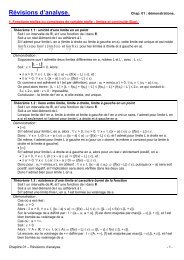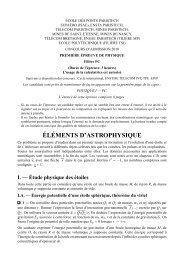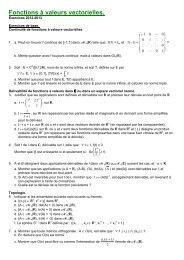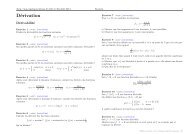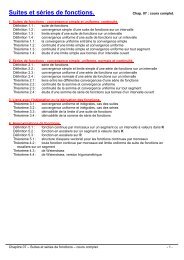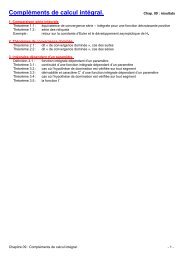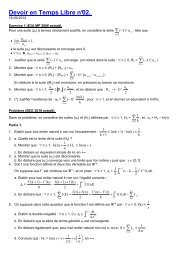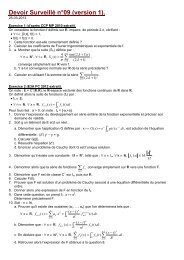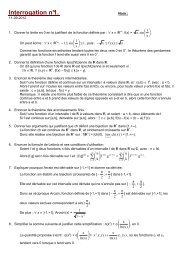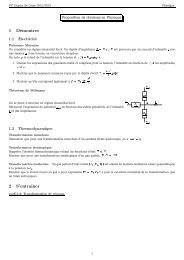Create successful ePaper yourself
Turn your PDF publications into a flip-book with our unique Google optimized e-Paper software.
[http://mp.cpgedupuydelome.fr] édité le 26 juillet 2013 Enoncés 1<br />
Fonctions <strong>usuelles</strong><br />
Logarithmes<br />
Exercice 1 [ 01827 ] [correction]<br />
Etablir, pour tout x 0, l’encadrement<br />
Exercice 2 [ 01828 ] [correction]<br />
a) Montrer que, pour tout x > −1<br />
x − 1<br />
2 x2 ln(1 + x) x<br />
ln(1 + x) x<br />
b) En déduire que pour tout n ∈ N\ {0, 1}<br />
Exercice 3 [ 01829 ] [correction]<br />
Montrer que pour tout a, b > 0<br />
Exercice 4 [ 01830 ] [correction]<br />
Soit 0 < a b. On pose f : x ↦→ ln(1+ax)<br />
<br />
1 + 1<br />
n <br />
e 1 −<br />
n<br />
1<br />
−n n<br />
1<br />
a + b<br />
(ln a + ln b) ln<br />
2 2<br />
ln(1+bx) définie sur R+⋆ .<br />
Etudier la monotonie de f et en déduire que ln 1 + a<br />
b<br />
ln 1 + b<br />
a<br />
(ln 2) 2 .<br />
Exercice 5 [ 01831 ] [correction]<br />
Montrer que le nombre de chiffres dans l’écriture décimale d’un entier n > 0 est<br />
E (log 10 n) + 1.<br />
Exercice 6 [ 01832 ] [correction]<br />
a) Etablir que pour tout x, y ∈ R + , √ y − √ x |y − x|.<br />
b) Ce résultat est-il encore vrai en terme de racine cubique ?<br />
Exercice 7 [ 03626 ] [correction]<br />
[Lemme de Gibbs]<br />
a) Justifier<br />
∀x > 0, ln x x − 1<br />
b) Soient (p1, . . . , pn) et (q1, . . . , qn) des n-uplets formés de réels strictement<br />
positifs vérifiant<br />
n n<br />
qk = 1<br />
Etablir<br />
k=1<br />
pk =<br />
k=1<br />
n<br />
pi ln qi <br />
i=1<br />
Dans quel(s) cas y a-t-il égalité ?<br />
n<br />
i=1<br />
Puissances et exponentielles<br />
Exercice 8 [ 01833 ] [correction]<br />
Simplifier a b pour a = exp x 2 et b = 1<br />
x ln x1/x .<br />
pi ln pi<br />
Exercice 9 [ 01834 ] [correction]<br />
Parmi les relations suivantes, lesquelles sont exactes :<br />
a) (a b ) c = a bc<br />
d) (ab) c = a c/2 b c/2<br />
b) a b a c = a bc<br />
e) (a b ) c = a (bc )<br />
Exercice 10 [ 01835 ] [correction]<br />
Comparer<br />
lim<br />
x→0 + x(xx ) et lim<br />
x→0 +(xx ) x<br />
Exercice 11 [ 01836 ] [correction]<br />
Déterminer les limites suivantes :<br />
a) lim<br />
x→+∞ x1/x<br />
b) lim<br />
x→0 x √ x<br />
c) a 2b = (a b ) 2<br />
f) (a b ) c = (a c ) b ?<br />
c) lim x1/x<br />
x→0 +<br />
Diffusion autorisée à titre entièrement gratuit uniquement - dD
[http://mp.cpgedupuydelome.fr] édité le 26 juillet 2013 Enoncés 2<br />
Exercice 12 [ 01837 ] [correction]<br />
Résoudre les équations suivantes :<br />
a) e x + e 1−x = e + 1 b) x √ x = ( √ x) x c) 2 2x − 3 x−1/2 = 3 x+1/2 − 2 2x−1 .<br />
Exercice 13 [ 01838 ] [correction]<br />
Résoudre les systèmes suivants :<br />
<br />
x<br />
8 = 10y<br />
a)<br />
2 x = 5y<br />
b)<br />
e x e 2y = a<br />
2xy = 1<br />
Exercice 14 [ 03438 ] [correction]<br />
Montrer<br />
∀x ∈ ]0, 1[ , x x (1 − x) 1−x 1<br />
2<br />
Exercice 15 [ 03652 ] [correction]<br />
Résoudre le système a + b + c = 0<br />
d’inconnue (a, b, c) ∈ R 3<br />
e a + e b + e c = 3<br />
Fonctions trigonométriques<br />
Exercice 16 [ 01839 ] [correction]<br />
Etablir que pour tout x ∈ R + , on a sin x x et pour tout x ∈ R, cos x 1 − x2<br />
2 .<br />
Exercice 17 [ 01840 ] [correction]<br />
Développer :<br />
Exercice 18 [ 01841 ] [correction]<br />
Calculer cos π<br />
8<br />
en observant 2 × π<br />
8<br />
a) cos 3a b) tan(a + b + c)<br />
= π<br />
4 .<br />
Exercice 19 [ 01842 ] [correction]<br />
Simplifier<br />
En déduire la valeur de<br />
Exercice 20 [ 01843 ] [correction]<br />
Linéariser :<br />
cos p − cos q<br />
sin p + sin q<br />
tan π<br />
24<br />
a) cos 2 x b) cos x sin 2 x c) cos 2 x sin 2 x<br />
d) cos a cos b e) cos a cos b cos c<br />
Exercice 21 [ 01844 ] [correction]<br />
Ecrire sous la forme A cos(x − ϕ) les expressions suivantes :<br />
a) cos x + sin x b) cos x − √ 3 sin x<br />
Exercice 22 [ 01845 ] [correction]<br />
Pour a, b ∈ R tels que b = 0 [2π], calculer simultanément<br />
n<br />
cos(a + kb) et<br />
k=0<br />
Exercice 23 [ 01846 ] [correction]<br />
Soit x = 0 [2π].<br />
a) Montrer<br />
n<br />
sin(a + kb)<br />
k=0<br />
sin x + sin 2x + · · · + sin nx =<br />
en procédant par récurrence sur n ∈ N.<br />
b) En exploitant les nombres complexes.<br />
Exercice 24 [ 01847 ] [correction]<br />
Résoudre les équations suivantes d’inconnues x ∈ R.<br />
sin (n+1)x<br />
2<br />
sin x<br />
2<br />
sin nx<br />
2<br />
Diffusion autorisée à titre entièrement gratuit uniquement - dD
[http://mp.cpgedupuydelome.fr] édité le 26 juillet 2013 Enoncés 3<br />
a) cos(2x − π/3) = sin(x + 3π/4) b) cos 4 x + sin 4 x = 1<br />
c) sin x + sin 3x = 0 d) sin x + sin 2x + sin 3x = 0<br />
e) 3 cos x − √ 3 sin x = √ 6 f) 2 sin x. cos x + √ 3 cos 2x = 0<br />
Exercice 25 [ 01848 ] [correction]<br />
Résoudre l’équation<br />
tan x tan 2x = 1<br />
Exercice 26 Mines-Ponts MP [ 02645 ] [correction]<br />
Calculer<br />
4<br />
k=1<br />
2 kπ cos 9 .<br />
Fonctions trigonométriques inverses<br />
Exercice 27 [ 01849 ] [correction]<br />
Simplifier les expressions suivantes :<br />
a) cos(2 arccos x) b) cos(2 arcsin x) c) sin(2 arccos x)<br />
d) cos(2 arctan x) e) sin(2 arctan x) f) tan(2 arcsin x)<br />
Exercice 28 [ 01850 ] [correction]<br />
Simplifier la fonction x ↦→ arccos(4x 3 − 3x) sur son intervalle de définition.<br />
Exercice 29 [ 01851 ] [correction]<br />
Simplifier arcsin x<br />
√ 1+x 2 .<br />
Exercice 30 [ 01852 ] [correction]<br />
Montrer que la courbe représentative de la fonction arccos est symétrique par<br />
rapport au point de coordonnées (0, π/2).<br />
Exercice 31 [ 01853 ] [correction]<br />
Déterminer lim<br />
x→0+<br />
arccos(1−x)<br />
√ x<br />
à l’aide d’un changement de variable judicieux.<br />
Exercice 32 [ 01854 ] [correction]<br />
Etudier les fonctions suivantes afin de les représenter :<br />
a) f : x ↦→ arcsin(sin x) + arccos(cos x) b) f : x ↦→ arcsin(sin x) + 1<br />
arccos(cos 2x)<br />
2<br />
1 + cos x<br />
1 − cos x<br />
c) f : x ↦→ arccos<br />
d) f : x ↦→ arctan<br />
2<br />
1 + cos x<br />
Exercice 33 [ 01855 ] [correction]<br />
Simplifier :<br />
a) arctan 1<br />
2<br />
+ arctan 1<br />
5<br />
+ arctan 1<br />
8 .<br />
b) arctan 2 + arctan 3 + arctan(2 + √ 3).<br />
c) arcsin 4<br />
5<br />
+ arcsin 5<br />
13<br />
+ arcsin 16<br />
65 .<br />
Exercice 34 [ 01856 ] [correction]<br />
Résoudre les équations suivantes d’inconnue x réelle :<br />
a) arcsin x = arcsin 4 5<br />
+ arcsin b) arcsin tan x = x<br />
5 13<br />
c) arccos x = arcsin 2x d) arctan x + arctan x √ 3 = 7π<br />
12<br />
2x<br />
tan x<br />
e) arcsin = arctan x f) arcsin = x<br />
1 + x2 2<br />
Exercice 35 [ 01857 ] [correction]<br />
On appelle argument principal d’un complexe z non nul, l’unique θ ∈ ]−π, π] tel<br />
que z = |z| e iθ .<br />
Montrer que si z ∈ C\R − alors θ = 2 arctan<br />
y = Im(z).<br />
Exercice 36 [ 01858 ] [correction]<br />
Simplifier arctan a + arctan b pour a, b 0.<br />
y<br />
x+ √ x2 avec x = Re(z) et<br />
+y2 Exercice 37 [ 01859 ] [correction]<br />
Soit p ∈ N. Calculer arctan(p + 1) − arctan(p).<br />
Etudier la limite de la suite (Sn) de terme général : Sn = n<br />
p=0<br />
arctan<br />
1<br />
p 2 +p+1 .<br />
Diffusion autorisée à titre entièrement gratuit uniquement - dD
[http://mp.cpgedupuydelome.fr] édité le 26 juillet 2013 Enoncés 4<br />
Exercice 38 [ 01860 ] [correction]<br />
a) Calculer<br />
b) Etablir, pour tout n ∈ N<br />
c) Justifier<br />
d) En déduire<br />
1<br />
0<br />
0 <br />
n<br />
k=0<br />
1<br />
0<br />
1<br />
0<br />
dt<br />
1 + t 2<br />
(−1) k t 2k dt = π<br />
4 +<br />
1<br />
(−1)<br />
0<br />
nt2n+2 1 + t2 dt<br />
t2n+2 dt <br />
1 + t2 n<br />
k=0<br />
1<br />
0<br />
t 2n+2 dt =<br />
(−1) k<br />
2k + 1 −−−→<br />
π<br />
n→∞ 4<br />
1<br />
2n + 3<br />
Exercice 39 Mines-Ponts MP [ 02814 ] [correction]<br />
Soient x1, . . . , x13 des réels. Montrer qu’il existe i et j dans {1, . . . , 13} tels que<br />
i = j et 0 xi−xj<br />
1+xixj 2 − √ 3. Indice : Utiliser la fonction tan.<br />
Fonctions hyperboliques<br />
Exercice 40 [ 01861 ] [correction]<br />
Etablir que pour tout x ∈ R + , on a shx x et pour tout x ∈ R, chx 1 + x2<br />
2 .<br />
Exercice 41 [ 01862 ] [correction]<br />
Soit y ∈ − π<br />
<br />
π<br />
y π<br />
, . On pose x = ln tan + .<br />
2<br />
2<br />
Montrer que th x<br />
2<br />
= tan y<br />
2<br />
Exercice 42 [ 01863 ] [correction]<br />
Pour n ∈ N et a, b ∈ R, calculer<br />
, thx = sin y et chx = 1<br />
cos y .<br />
2<br />
n<br />
ch(a + kb) et<br />
k=0<br />
4<br />
n<br />
sh(a + kb)<br />
k=0<br />
Exercice 43 [ 01864 ] [correction]<br />
Pour n ∈ N et x ∈ R, simplifier Pn(x) = n<br />
k=1<br />
Exercice 44 [ 01865 ] [correction]<br />
Pour n ∈ N et x ∈ R +⋆ , observer th((n + 1)x) − th(nx) =<br />
Calculer Sn(x) = n<br />
k=0<br />
1<br />
ch(kx)ch((k+1)x) .<br />
Exercice 45 [ 01866 ] [correction]<br />
Soient a et α deux réels.<br />
Résoudre le système d’inconnues x et y<br />
chx + chy = 2achα<br />
Exercice 46 [ 01869 ] [correction]<br />
Etablir :<br />
shx + shy = 2ashα<br />
∀x ∈ R, |arctan(shx)| = arccos<br />
Fonctions hyperboliques inverses<br />
Exercice 47 [ 01867 ] [correction]<br />
Simplifier les expressions suivantes :<br />
Exercice 48 [ 01868 ] [correction]<br />
Simplifier :<br />
ch x<br />
2k <br />
en calculant Pn(x)sh x<br />
2n <br />
.<br />
<br />
1<br />
chx<br />
a) ch(argshx) b) th(argshx) c) sh(2argshx)<br />
d) sh(argchx) e) th(argchx) f) ch(argthx)<br />
a) argch(2x 2 − 1) b) argsh(2x 1 + x 2 )<br />
Exercice 49 [ 01870 ] [correction]<br />
Résoudre l’équation<br />
argshx + argchx = 1<br />
shx<br />
ch(nx)ch((n+1)x) .<br />
Diffusion autorisée à titre entièrement gratuit uniquement - dD
[http://mp.cpgedupuydelome.fr] édité le 26 juillet 2013 Enoncés 5<br />
Exercice 50 [ 01871 ] [correction]<br />
Soit G : − π<br />
2<br />
, π<br />
2<br />
→ R définie par G(t) = argsh(tan t).<br />
Montrer que G est dérivable et que pour tout t ∈ − π<br />
2<br />
<br />
π ′ , 2 , G (t) = chG(t).<br />
Diffusion autorisée à titre entièrement gratuit uniquement - dD
[http://mp.cpgedupuydelome.fr] édité le 26 juillet 2013 Corrections 6<br />
Corrections<br />
Exercice 1 : [énoncé]<br />
L’étude des variations des fonctions x ↦→ x − ln(1 + x) et x ↦→ ln(1 + x) − x + 1<br />
2x2 montre que celles-ci sont croissantes sur R + , puisqu’elles s’annulent en 0, on peut<br />
conclure.<br />
Exercice 2 : [énoncé]<br />
a) Posons f : ]−1, +∞[ → R définie par f(x) = x − ln(1 + x). f est dérivable,<br />
f(0) = 0 et f ′ (x) = x<br />
1+x .<br />
Le tableau de variation de f donne f positive.<br />
b) D’une part<br />
et d’autre part<br />
car<br />
<br />
1 + 1<br />
n 1 n ln(1+<br />
= e n<br />
n<br />
) 1 n×<br />
e n e<br />
<br />
1 − 1<br />
−n 1<br />
−n ln(1−<br />
= e n<br />
n<br />
) e<br />
<br />
ln 1 − 1<br />
<br />
−<br />
n<br />
1<br />
n<br />
Exercice 3 : [énoncé]<br />
On a<br />
<br />
a + b<br />
ln −<br />
2<br />
1<br />
a + b<br />
(ln a + ln b) = ln<br />
2 2 √ ab<br />
or<br />
a + b = √ a 2 + √ b 2<br />
2 √ ab<br />
donc<br />
a + b<br />
ln<br />
2 √ 0<br />
ab<br />
Exercice 4 : [énoncé]<br />
f ′ g(x)<br />
(x) = (1+ax)(1+bx) ln(1+bx) 2 avec g(x) = a(1 + bx) ln(1 + bx) − b(1 + ax) ln(1 + ax).<br />
g(0) = 0 et g ′ (x) = ab ln 1+bx<br />
1+ax 0 donc g est positive et par suite f croissante.<br />
1 1<br />
b a donc f <br />
1 1<br />
b f a ce qui donne l’inégalité voulue.<br />
Exercice 5 : [énoncé]<br />
Notons m le nombre de décimale dans l’écriture de n.<br />
On a 10 m−1 n < 10 m donc m − 1 log 10 n < m puis m = E(log 10 n) + 1.<br />
Exercice 6 : [énoncé]<br />
a) Quitte à échanger, on peut supposer y x.<br />
Par élévation au carré, l’inégalité demandée équivaut à y − 2 √ xy + x y − x.<br />
Or y x donc √ xy x puis y − 2 √ xy + x y − x ce qui permet de conclure.<br />
b) Quitte à échanger, on peut encore supposer y x.<br />
Par élévation au cube, l’inégalité demandée équivaut à<br />
y − 3 3 y 2 x + 3 3 yx 2 − x y − x.<br />
Or y x donc y 2 x yx 2 puis y − 3 3 y 2 x + 3 3 yx 2 − x y − x.<br />
Exercice 7 : [énoncé]<br />
a) Une étude de la fonction x ↦→ ln x − x + 1 assure l’inégalité écrite.<br />
De plus on observe qu’il y a égalité si, et seulement si, x = 1.<br />
b) On étudie la différence<br />
n<br />
pi ln qi −<br />
i=1<br />
Par l’inégalité précédente<br />
n<br />
pi ln qi −<br />
i=1<br />
n<br />
pi ln pi <br />
i=1<br />
n<br />
pi ln pi =<br />
i=1<br />
n<br />
i=1<br />
De plus il y a égalité si, et seulement si,<br />
pi<br />
qi<br />
pi<br />
∀1 i n, pi = qi<br />
n<br />
pi ln<br />
i=1<br />
qi<br />
pi<br />
<br />
− 1 =<br />
n<br />
(qi − pi) = 0<br />
Cette inégalité est fameuse lorsqu’on s’intéresse à l’entropie d’une source<br />
d’information. . .<br />
Exercice 8 : [énoncé]<br />
(exp x2 ln x1/x<br />
) x = x.<br />
Exercice 9 : [énoncé]<br />
a) c) f)<br />
i=1<br />
Diffusion autorisée à titre entièrement gratuit uniquement - dD
[http://mp.cpgedupuydelome.fr] édité le 26 juillet 2013 Corrections 7<br />
Exercice 10 : [énoncé]<br />
Quand x → 0 +<br />
et<br />
Exercice 11 : [énoncé]<br />
a) lim<br />
x→+∞ x1/x = 1<br />
b) lim<br />
x→0 x √ x = 1<br />
c) lim<br />
x→0 + x1/x = 0.<br />
x (xx ) = exp(x x ln x) = exp(exp(x ln x) ln x) → 0<br />
(x x ) x = exp(x ln x x ) = exp(x 2 ln x) → 1<br />
Exercice 12 : [énoncé]<br />
a) S = {0, 1} b) S = {0, 1, 4} c) Obtenir 2 2x−3 = 3 x−3/2 puis S = {3/2}.<br />
Exercice 13 : [énoncé]<br />
a) x = 1/2, y = √ 2/5<br />
b) Obtenir un système somme/produit en x et 2y puis le résoudre.<br />
Exercice 14 : [énoncé]<br />
On a<br />
avec<br />
x x (1 − x) 1−x = exp ϕ(x)<br />
ϕ(x) = x ln x + (1 − x) ln(1 − x)<br />
La fonction ϕ est dérivable sur ]0, 1[ et<br />
ϕ ′ <br />
x<br />
(x) = ln<br />
1 − x<br />
On en déduit que ϕ est décroissante sur ]0, 1/2] puis croissante sur [1/2, 1[ donc<br />
∀x ∈ ]0, 1[ , ϕ(x) ϕ(1/2) = ln(1/2)<br />
Exercice 15 : [énoncé]<br />
Il est clair que le triplet nul est solution de ce système.<br />
Inversement, soit (a, b, c) solution. Posons x = e a , y = e b de sorte que<br />
e c = e −(a+b) = 1/xy.<br />
On a donc x, y > 0 et<br />
x + y + 1<br />
= 3<br />
xy<br />
Pour y > 0 fixé, étudions la fonction f : x ↦→ x + y + 1/xy.<br />
Cette fonction est dérivable et admet un minimum strict en x = 1/ √ y valant<br />
g(y) = y + 2/ √ y.<br />
La fonction g est dérivable et admet un minimum strict en y = 1 valant g(1) = 3.<br />
On en déduit que si (x, y) = (1, 1) alors f(x, y) > 3 et donc<br />
On peut alors conclure a = b = c = 0.<br />
f(x, y) = 3 ⇒ x = y = 1<br />
Exercice 16 : [énoncé]<br />
Posons f(x) = x − sin x définie sur R + .<br />
f est dérivable, f ′ 0 et f(0) = 0 donc f est positive.<br />
Posons g(x) = cos x − 1 + x2 définie sur R.<br />
2<br />
g est deux fois dérivable, g ′′ 0, g ′ (0) = g(0) = 0 permet de dresser les tableaux<br />
de variation et de signe de g ′ puis de g. On conclut g positive.<br />
Exercice 17 : [énoncé]<br />
a) cos 3a = cos(2a + a) puis<br />
b) tan(a + b + c) = tan((a + b) + c) puis<br />
tan(a + b + c) =<br />
Exercice 18 : [énoncé]<br />
On sait cos 2a = 2 cos 2 a − 1 donc<br />
cos 3a = 4 cos 3 a − 3 cos a<br />
tan a + tan b + tan c − tan a tan b tan c<br />
1 − tan a tan b − tan b tan c − tan c tan a<br />
2 π<br />
2 cos − 1 =<br />
8<br />
√ 2<br />
2<br />
Diffusion autorisée à titre entièrement gratuit uniquement - dD
[http://mp.cpgedupuydelome.fr] édité le 26 juillet 2013 Corrections 8<br />
puis<br />
et enfin<br />
Exercice 19 : [énoncé]<br />
Par factorisation<br />
cos p − cos q<br />
sin p + sin q<br />
Pour p = π<br />
4<br />
et q = π<br />
6<br />
on obtient<br />
tan π<br />
24 =<br />
2 π<br />
cos<br />
8 =<br />
√<br />
2 + 2<br />
4<br />
cos π<br />
8 =<br />
√<br />
2 + 2<br />
2<br />
p−q<br />
sin 2 = −<br />
cos p−q<br />
2<br />
√<br />
3<br />
2 − √ 2<br />
√<br />
2<br />
2 1<br />
2 + 2<br />
=<br />
= − tan<br />
√ 3 − √ 2<br />
√ 2 + 1<br />
p − q<br />
2<br />
Exercice 20 : [énoncé]<br />
a) cos2 x = 1<br />
1<br />
2 cos 2x + 2 .<br />
b) cos x sin2 x = 1<br />
1<br />
4 cos x − 4 cos 3x.<br />
c) cos2 x sin2 x = 1<br />
4 sin2 2x = 1<br />
8 (1 − cos 4x)<br />
d) cos a cos b = 1<br />
2 (cos(a + b) + cos(a − b))<br />
e) cos a cos b cos c =<br />
(cos(a + b + c) + cos(a + b − c) + cos(a − b + c) + cos(a − b − c)).<br />
1<br />
4<br />
Exercice 21 : [énoncé]<br />
a) cos x + sin x = √ 2 cos(x − π/4).<br />
b) cos x − √ 3 sin x = 2 cos(x + π/3).<br />
Exercice 22 : [énoncé]<br />
En passant aux nombres complexes<br />
n<br />
n<br />
cos(a + kb) + i sin(a + kb) =<br />
k=0<br />
k=0<br />
n<br />
e i.(a+kb)<br />
Par sommation géométrique puis factorisation de l’exponentielle équilibrée<br />
n<br />
k=0<br />
e i.(a+kb) = e i.a ei(n+1)b − 1<br />
e ib − 1<br />
k=0<br />
(n+1)b<br />
sin 2<br />
= ei(a+nb/2)<br />
sin b<br />
2<br />
Par suite<br />
et<br />
n<br />
cos(a + k.b) =<br />
k=0<br />
n<br />
sin(a + k.b) =<br />
k=0<br />
sin (n+1)b<br />
2<br />
sin b<br />
2<br />
sin (n+1)b<br />
2<br />
sin b<br />
2<br />
Exercice 23 : [énoncé]<br />
a) L’hérédité de la récurrence s’obtient via :<br />
sin<br />
(n + 1)x<br />
2<br />
en exploitant<br />
avec<br />
sin nx<br />
2<br />
b) Par les nombres complexes<br />
donc<br />
x (n + 1)x<br />
+ sin(n + 1)x sin = sin<br />
2 2<br />
= sin<br />
(n + 1)x<br />
2<br />
sin p − sin q = 2 sin<br />
p =<br />
(n + 2)x<br />
2<br />
sin x + sin 2x + · · · + sin nx = Im(<br />
sin<br />
p − q<br />
2<br />
cos(a + nb<br />
2 )<br />
sin(a + nb<br />
2 )<br />
(n + 2)x<br />
2<br />
cos<br />
et q = nx<br />
2<br />
<br />
sin nx (n + 1)x<br />
+ 2 cos sin<br />
2 2<br />
x<br />
<br />
2<br />
p + q<br />
2<br />
n<br />
e ikx ) = Im<br />
k=1<br />
<br />
(n+1)x<br />
i<br />
sin x + sin 2x + · · · + sin nxIm e 2<br />
Exercice 24 : [énoncé]<br />
a) L’équation étudiée équivaut à<br />
On obtient pour solutions<br />
sin nx<br />
2<br />
sin x<br />
<br />
= sin<br />
2<br />
cos(2x − π/3) = cos(x + π/4)<br />
x = 7π<br />
12<br />
[2π] et x = π<br />
36<br />
<br />
2π<br />
3<br />
e ix − e i(n+1)x<br />
1 − e ix<br />
(n + 1)x<br />
2<br />
<br />
sin nx<br />
2<br />
sin x<br />
2<br />
Diffusion autorisée à titre entièrement gratuit uniquement - dD
[http://mp.cpgedupuydelome.fr] édité le 26 juillet 2013 Corrections 9<br />
b) L’équation étudiée équivaut à<br />
soit encore<br />
On obtient pour solutions<br />
c) L’équation étudiée équivaut à<br />
On obtient pour solutions<br />
d) L’équation étudiée équivaut à<br />
On obtient pour solutions<br />
cos 4 x + sin 4 x = (cos 2 x + sin 2 x) 2<br />
2 cos 2 x sin 2 x = 0<br />
2 sin(2x)<br />
x = 0 [π/2] , x = 2π<br />
3<br />
e) L’équation étudiée équivaut à<br />
2 √ √<br />
3<br />
3<br />
2<br />
soit encore<br />
On obtient pour solutions<br />
x = π<br />
12<br />
x = 0 [π/2]<br />
2 sin 2x cos x = 0<br />
x = 0 [π/2]<br />
<br />
cos x + 1<br />
<br />
= 0<br />
2<br />
[2π] et x = −2π<br />
3<br />
<br />
1<br />
cos x − sin x =<br />
2 √ 6<br />
<br />
cos x + π<br />
<br />
6<br />
= cos π<br />
4<br />
[2π] et x = − 5π<br />
12<br />
f) L’équation étudiée équivaut à<br />
√<br />
1 3<br />
2 sin 2x +<br />
2 2<br />
soit encore<br />
On obtient pour solutions<br />
x = π<br />
3<br />
<br />
sin 2x + π<br />
<br />
3<br />
[2π]<br />
<br />
cos 2x = 0<br />
= 0<br />
[π] et x = − π<br />
6<br />
[π]<br />
[2π]<br />
Exercice 25 : [énoncé]<br />
Pour x = π<br />
2<br />
[π] et x = π<br />
4<br />
<br />
π<br />
2 ,<br />
tan x tan 2x = 1 ⇔ sin x sin 2x − cos x cos 2x = 0 ⇔ cos 3x = 0 ⇔ x = π<br />
6<br />
<br />
π<br />
3 .<br />
Exercice 26 : [énoncé]<br />
En linéarisant et en faisant quelques transformations angulaires de simplification<br />
4<br />
k=1<br />
2 kπ 7 cos 9 = 4 .<br />
Exercice 27 : [énoncé]<br />
a) cos(2 arccos x) = 2 cos2 (arccos x) − 1 = 2x2 − 1.<br />
b) cos(2 arcsin x) = 1 − 2 sin2 arcsin x = 1 − 2x2 .<br />
c) sin(2 arccos x) = 2x √ 1 − x2 d) cos(2 arctan x) = 2 cos2 arctan x − 1 = 2<br />
1+x2 − 1 = 1−x2<br />
1+x2 .<br />
e) sin(2 arctan x) = 2 sin(arctan x) cos(arctan x) = 2x<br />
f) tan(2 arcsin x) =<br />
2 tan(arcsin x)<br />
1−tan 2 (arcsin x) = 2x√ 1−x 2<br />
1−2x 2 .<br />
1+x 2 .<br />
Exercice 28 : [énoncé]<br />
f : x ↦→ arccos(4x 3 − 3x) est définie sur [−1, 1].<br />
Pour x ∈ [−1, 1], posons θ = arccos x, on a alors<br />
f(x) = arccos(4 cos 3 θ − 3 cos θ) = arccos(cos 3θ).<br />
Si θ ∈ [0, π/3] i.e. x ∈ [1/2, 1] alors f(x) = 3θ = 3 arccos x.<br />
Si θ ∈ [π/3, 2π/3] i.e. x ∈ [−1/2, 1/2] alors f(x) = 2π − 3θ = 2π − 3 arccos x.<br />
Si θ ∈ [2π/3, π] i.e. x ∈ [−1, −1/2] alors f(x) = 3θ − 2π = 3 arccos x − 2π.<br />
Exercice 29 : [énoncé]<br />
La fonction x ↦→ x<br />
√ 1+x 2<br />
x ↦→ arcsin x<br />
√ 1+x 2<br />
est dérivable et à valeurs dans ]−1, 1[ donc<br />
<br />
′<br />
x<br />
est dérivable et arcsin √ =<br />
<br />
1+x2 x<br />
donc arcsin √ = arctan x + C.<br />
1+x2 En évaluant en x = 0, on obtient C = 0.<br />
1<br />
( √ 1+x 2 ) 3/2<br />
1<br />
1− x2<br />
1+x 2<br />
= 1<br />
1+x 2<br />
Exercice 30 : [énoncé]<br />
Calculons arccos(x) + arccos(−x).<br />
On a cos(arccos(x) + arccos(−x)) = −x 2 − (1 − x 2 ) = −1 et<br />
arccos(x) + arccos(−x) ∈ [0, 2π] donc arccos(x) + arccos(−x) = π ce qui permet de<br />
justifier la symétrie avancée.<br />
Diffusion autorisée à titre entièrement gratuit uniquement - dD
[http://mp.cpgedupuydelome.fr] édité le 26 juillet 2013 Corrections 10<br />
Exercice 31 : [énoncé]<br />
Quand x → 0 + : arccos(1−x)<br />
√ = √ y<br />
avec y = arccos(1 − x) → 0 x<br />
1−cos(y) + .<br />
Or 1 − cos(y) ∼ y2<br />
2<br />
donc arccos(1−x)<br />
√ x<br />
=<br />
√ y<br />
→<br />
1−cos(y) √ 2.<br />
Exercice 32 : [énoncé]<br />
a) f est 2π périodique.<br />
Sur [−π/2, 0] : arcsin(sin x) = x et arccos(cos x) = −x donc f(x) = 0.<br />
Sur [0, π/2] : arcsin(sin x) = x et arccos(cos(x)) = x donc f(x) = 2x.<br />
Sur [π/2, π] : arcsin(sin x) = π − x et arccos(cos x) = x donc f(x) = π.<br />
Sur [−π, −π/2] : arcsin(sin x) = −x − π et arccos(cos(x)) = −x donc<br />
f(x) = −2x − π.<br />
b) f est 2π périodique.<br />
Sur [0, π/2], f(x) = x + x = 2x. Sur [π/2, π], f(x) = π − x + π − x = 2π − 2x.<br />
Sur [−π/2, 0], f(x) = x − x = 0. Sur [−π, −π/2], f(x) = −x − π + π + x = 0.<br />
c) f(x) = arccos<br />
f(x) = x/2.<br />
d) f(x) = arctan<br />
1+cos x<br />
2<br />
= arccos |cos(x/2)|. f est 2π périodique, paire, sur [0, π]<br />
<br />
1−cos x<br />
1+cos x = arctan |tan x/2|. f est 2π périodique, paire. Sur<br />
[0, π[ , f(x) = x/2. On retrouve la fonction ci-dessus.<br />
Exercice 33 : [énoncé]<br />
a) Posons θ = arctan 1<br />
1 + arctan<br />
1<br />
2 5 + arctan 8 .<br />
On a 0 θ < 3 arctan 1 √ = π/2 et tan θ = 1 donc θ = π/4.<br />
3<br />
b) Posons θ = arctan 2 + arctan 3 + arctan 2 + √ 3 .<br />
On a 3 arctan 1 = 3π 3π<br />
4 θ < 2 et tan θ = 1 √ donc θ =<br />
3 7π<br />
6 .<br />
c) cos arcsin 4<br />
<br />
5 3 12 4 5 16<br />
5 + arcsin 13 = 5 13 − 5 13 = 65 et<br />
cos <br />
π<br />
16<br />
16 16<br />
2 − arcsin 65 = sin arcsin 65 = 65 .<br />
Or arcsin 4<br />
5<br />
5 + arcsin 13 ∈ 0, π<br />
<br />
π<br />
16<br />
2 et 2 − arcsin 65 ∈ 0, π<br />
<br />
2 d’où l’égalité<br />
arcsin 4<br />
5<br />
+ arcsin 5<br />
13<br />
Exercice 34 : [énoncé]<br />
a) S = {63/65}.<br />
b) S = {0}.<br />
c) S = 1/ √ 5 .<br />
d) S = {1}.<br />
e) S = 0, √ 3, − √ 3 .<br />
f) S = {0, π/3, −π/3}.<br />
+ arcsin 16<br />
65<br />
= π<br />
2<br />
Exercice 35 : [énoncé]<br />
Posons θ l’argument principal de z ∈ C\R − . On a θ ∈ ]−π, π[, cos θ =<br />
sin θ =<br />
√ y<br />
x2 +y2 .<br />
Posons α = 2 arctan<br />
y<br />
x+ √ x2 α<br />
. On a α ∈ ]−π, π[, t = tan<br />
+y2 cos α = 1−t2<br />
1+t2 = x2 +x √ x2 +y2 x2 +x √ x2 +y2 +y2 = √ x<br />
x2 +y2 et<br />
sin α = 2t<br />
1+t2 = y(x+√x2 +y2 )<br />
x2 +x √ x2 +y2 +y<br />
2 =<br />
√ y<br />
x2 +y2 Exercice 36 : [énoncé]<br />
On a tan(arctan a + arctan b) = a+b<br />
1−ab donc<br />
<br />
arctan a + arctan b = arctan [π].<br />
a+b<br />
1−ab<br />
donc α = θ.<br />
Si ab = 1 alors arctan a + arctan b = π/2. <br />
a+b<br />
Si ab < 1 alors arctan a + arctan b = arctan 1−ab .<br />
<br />
Si ab > 1 alors arctan a + arctan b = arctan + π.<br />
p=0<br />
a+b<br />
1−ab<br />
2 =<br />
y<br />
x+ √ x2 ,<br />
+y2 √ x<br />
x2 +y2 et<br />
Exercice 37 : [énoncé]<br />
Posons θ = arctan(p + 1) − arctan(p). Comme 0 arctan p arctan(p + 1) < π/2<br />
on a θ ∈ [0, π/2[.<br />
1<br />
De plus tan θ = p2 1<br />
+p+1 donc θ = arctan p2 +p+1 .<br />
Sn = n<br />
1 arctan p2 +p+1 = ... = arctan(n + 1) → π/2.<br />
Exercice 38 : [énoncé]<br />
a) 1 dt<br />
0 1+t2 = [arctan t] 1 π<br />
0 = 4 .<br />
b) Par sommation géométrique<br />
c) 1<br />
0<br />
De plus<br />
1 n<br />
(−1)<br />
0<br />
k=0<br />
k t 2k 1<br />
1 + (−1)<br />
dt =<br />
0<br />
nt2n+2 1 + t2 dt = π<br />
4 +<br />
1<br />
(−1)<br />
0<br />
nt2n+2 1 + t2 dt<br />
t 2n+2<br />
1+t 2 dt 0 par intégration d’une fonction positive sur [0, 1].<br />
car 1<br />
1+t 2 1.<br />
1<br />
0<br />
t2n+2 dt <br />
1 + t2 1<br />
0<br />
t 2n+2 dt =<br />
1<br />
2n + 3<br />
Diffusion autorisée à titre entièrement gratuit uniquement - dD
[http://mp.cpgedupuydelome.fr] édité le 26 juillet 2013 Corrections 11<br />
d) On a<br />
donc<br />
n<br />
k=0<br />
(−1) k<br />
2k + 1 =<br />
n<br />
k=0<br />
car 1<br />
n<br />
1<br />
(−1)<br />
k=0<br />
0<br />
k t 2k 1 n<br />
dt = (−1)<br />
0<br />
k=0<br />
k t 2k dt<br />
(−1) k<br />
1<br />
π<br />
= + (−1)n<br />
2k + 1 4 0<br />
0<br />
t2n+2 dt → 0<br />
1 + t2 t2n+2 π<br />
dt →<br />
1 + t2 4<br />
Exercice 39 : [énoncé]<br />
Posons αi = arctan xi. Les α1, . . . , α13 évoluent dans ]−π/2, π/2[, en coupant cet<br />
intervalle en 12 intervalles contiguës de longueur π/12, on peut affirmer que deux<br />
éléments parmi les α1, . . . , α13 appartiennent au même intervalle (principe des<br />
et donc<br />
tiroirs). Ainsi il existe i = j vérifiant 0 αi − αj π<br />
12<br />
0 tan(αi − αj) tan π<br />
12 . Or tan(αi − αj) = xi−xj<br />
1+xixj<br />
et tan π<br />
12 = 2 − √ 3.<br />
Exercice 40 : [énoncé]<br />
Posons f(x) = shx − x définie sur R + . f est dérivable, f ′ 0 et f(0) = 0 donc f<br />
est positive.<br />
Posons g(x) = chx − 1 − x2<br />
2 définie sur R. g est deux fois dérivable, g′′ 0,<br />
g ′ (0) = g(0) = 0 permet de dresser les tableaux de variation et de signe de g ′ puis<br />
de g. On conclut g positive.<br />
Exercice 41 : [énoncé]<br />
th x<br />
2 = ex−1 ex y π tan( 2 + 4 )−1<br />
+1 =<br />
tan( y<br />
y π sin( 2 + 4 )−cos(<br />
π =<br />
2 + 4 )+1 y π<br />
2 + 4 )<br />
sin( y π<br />
2 + 4 )+cos( y<br />
π y<br />
sin( 4 + 2 )−sin(<br />
π =<br />
2 + 4 ) π y<br />
4 − 2 )<br />
sin( π y<br />
4 + 2 )+sin( π y<br />
4 − 2 ) =<br />
sin y π<br />
2 cos 4<br />
cos y π = tan<br />
2 sin 4<br />
y<br />
2 .<br />
thx = tan2 ( y π<br />
2 + 4 )−1<br />
tan2 ( y π<br />
2 + 4 )+1 = sin2 y π 2<br />
2 + 4 − cos y π<br />
π<br />
2 + 4 = − cos y + 2 = sin y.<br />
y π tan( 2 + 4 )+tan<br />
chx = −1 ( y π<br />
2 + 4 )<br />
2 = sin2 ( y π<br />
2 + 4 )+cos 2 ( y π<br />
2 + 4 )<br />
2 sin( y π<br />
2 + 4 ) cos( y π<br />
2 + 4 ) = 1<br />
sin(y+ π<br />
1<br />
2 ) = cos y .<br />
Exercice 42 : [énoncé]<br />
Posons<br />
C =<br />
n<br />
ch(a + kb) et S =<br />
k=0<br />
n<br />
sh(a + kb)<br />
k=0<br />
On a<br />
et<br />
C + S =<br />
C − S =<br />
On en déduit C et S.<br />
n<br />
e a+kb <br />
=<br />
k=0<br />
n<br />
e −(a+kb) <br />
=<br />
k=0<br />
a 1−e(n+1)b e 1−eb si b = 0<br />
(n + 1)ea si b = 0<br />
−a 1−e−(n+1)b<br />
e 1−e−b si b = 0<br />
(n + 1)e−a si b = 0<br />
Exercice 43 : [énoncé]<br />
Si x = 0 alors Pn(x) = 1, sinon Pn(x)sh x<br />
2n <br />
1 = . . . = 2n sh(x) donc<br />
Pn(x) = sh(x)<br />
2nsh(x/2n ) .<br />
Exercice 44 : [énoncé]<br />
th((n + 1)x) − th(nx) =<br />
Sn(x) = n<br />
k=0<br />
1<br />
ch(kx)ch((k+1)x)<br />
Exercice 45 : [énoncé]<br />
Si a < 1 alors S = ∅.<br />
Si a = 1 alors S = {(α, α)}.<br />
sh x<br />
ch(nx) ch((n+1)x)<br />
th((n+1)x)<br />
= sh(x) .<br />
se vérifier par calculs.<br />
Si a > 1 alors en faisant apparaître un système somme produit :<br />
S =<br />
<br />
(ln(a − a 2 − 1) + α, ln(a + a 2 − 1) + α), (ln(a + a 2 − 1) + α, ln(a − a 2 − 1) +<br />
Exercice 46 : [énoncé]<br />
Soit f : R + → R définie par f(x) = arctan(shx) − arccos <br />
1<br />
chx .<br />
La fonction f est continue sur R + et dérivable sur ]0, +∞[ .<br />
Pour x > 0,<br />
f ′ (x) = chx<br />
1 + sh 2 shx<br />
−<br />
x ch 2 x<br />
chx<br />
<br />
ch 2 x − 1<br />
= 1<br />
chx<br />
Donc f est constante sur ]0, +∞[ puis sur R + par continuité.<br />
Puisque f(0) = 0, on peut conclure que<br />
∀x ∈ R + <br />
1<br />
, |arctan(shx)| = arccos<br />
chx<br />
Par parité, le résultat se prolonge aussi à x ∈ R − .<br />
shx 1<br />
− = 0<br />
chx shx<br />
Diffusion autorisée à titre entièrement gratuit uniquement - dD
[http://mp.cpgedupuydelome.fr] édité le 26 juillet 2013 Corrections 12<br />
Exercice<br />
<br />
47 : [énoncé]<br />
a) cha =<br />
b) th(argshx) = x √<br />
1+x2 .<br />
1 + sh 2 a donc ch(argshx) = √ 1 + x 2 .<br />
c) sh(2argshx) = 2sh(argshx)ch(argchx) = 2x √ 1 + x2 .<br />
d) sh(argchx) = √ x2 − 1.<br />
e) th(argchx) = √ x2−1 x .<br />
f) th 2 a = 1 − 1<br />
ch2 donc ch(argthx) = √ 1<br />
a 1−x2 .<br />
Exercice 48 : [énoncé]<br />
a) Pour x 1, posons α = argchx<br />
On a<br />
argch(2x 2 − 1) = arg ch(2ch 2 α − 1) = argch(ch2α) = 2α = 2argchx<br />
Par parité , pour x ∈ ]−∞, −1] ∪ [1, +∞[,<br />
argch(2x 2 − 1) = 2argch |x|<br />
b) Posons α = argshx.<br />
On a 2x √ 1 + x 2 = 2shαchα = sh2α donc<br />
argsh(2x 1 + x 2 ) = 2α = 2argshx<br />
Exercice 49 : [énoncé]<br />
La fonction f : x ↦→ argshx + argchx est continue et strictement croissante sur<br />
[1, +∞[.<br />
f(1) = argsh(1) et lim<br />
+∞ f = +∞. Puisque sh1 1, argsh(1) 1.<br />
L’équation possède donc une unique solution a. Déterminons-la.<br />
sh(1) = sh(argsha + argcha) = a 2 + 1 + a 2 a 2 − 1 = a 2 + a 4 − 1<br />
donc a 4 − 1 = sh(1) − a 2<br />
puis<br />
et enfin<br />
a 2 = ch2 1<br />
2sh1<br />
a = ch1<br />
√ 2sh1<br />
Exercice 50 : [énoncé]<br />
G est dérivable par composition et G ′ (t) = 1 + tan2 <br />
t. Or<br />
chG(t) = 1 + sh 2 G(t) = 1 + tan2 t.<br />
Diffusion autorisée à titre entièrement gratuit uniquement - dD


![+Fonctions usuelles [pdf]](https://img.yumpu.com/18433373/1/500x640/-fonctions-usuelles-pdf.jpg)
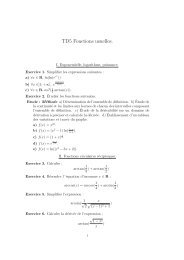
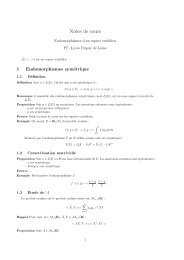
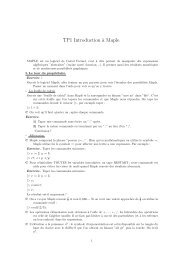

![[http://mp.cpgedupuydelome.fr] édité le 4 juin 2013 Enoncés 1 ...](https://img.yumpu.com/19249082/1/190x135/http-mpcpgedupuydelomefr-edite-le-4-juin-2013-enonces-1-.jpg?quality=85)
